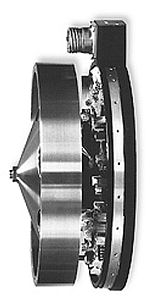- Reaction wheel
-
A reaction wheel is a type of flywheel used primarily by spacecraft for attitude control without using fuel for rockets or other reaction devices.
Reaction wheels are devices which aim a spacecraft in different directions without firing rockets or jets. They are particularly useful when the spacecraft must be rotated by very small amounts, such as keeping a telescope pointed at a star. They may also reduce the mass fraction needed for fuel. This is accomplished by equipping the spacecraft with an electric motor attached to a flywheel, which when rotated increasingly fast causes the spacecraft to spin the other way in a proportional amount by conservation of angular momentum. Reaction wheels can only rotate the spacecraft around its center of mass (see torque), they are not capable of moving the spacecraft from one place to another (see translational force). Reaction wheels work around a nominal zero rotation speed. However, external torques on the spacecraft may require a gradual buildup of reaction wheel rotation speed to maintain the spacecraft in a fixed orientation.
Momentum wheels (used in the Hubble Space Telescope) are a different type of actuator, mainly used for gyroscopic stabilization of spacecraft: momentum wheels have high rotation speeds (around 6000 rpm) and mass.[citation needed]
Implementation
Reaction wheels are usually implemented as special electric motors, mounted along the x, y and z axes. Changes in speed rate (in either direction) are controlled electronically by computer controls. The strength of the materials of a reaction wheel determines the speed at which the wheel would come apart, and therefore how much angular momentum it can store.
Since the reaction wheel is a small fraction of the spacecraft's total mass, easily-measurable changes in its speed provide very precise changes in angle. It therefore permits very precise changes in a spacecraft's attitude. For this reason, reaction wheels are often used to aim spacecraft with cameras or telescopes.
Over time reaction wheels may build up stored momentum that needs to be cancelled. Designers therefore supplement reaction wheel systems with other attitude control mechanisms. In the presence of a magnetic field (as in low Earth orbit), a spacecraft can employ magnetorquers (better known as torque rods) to transfer angular momentum to the Earth through its magnetic field. In the absence of a magnetic field, the most efficient practice is to use high-efficiency attitude jets such as ion thrusters, or small, lightweight solar sails on the ends of projecting masts or solar cell arrays. Most spacecraft, however, also need fast pointing, and cannot afford the extra mass of three attitude control systems. Designers therefore usually use conventional monopropellant vernier engines to cancel reaction wheels, as well as for fast pointing.[citation needed]
See also
- Attitude control
- Control moment gyroscope
- Flywheel
- MicroWheel
- Reaction control system
- Spacecraft propulsion
- ROSAT, a satellite lost when limitations in its control envelope were exceeded.
External links
- Sinclair, Doug; Grant, C. Cordell; Zee, Robert E. (2007). "Enabling Reaction Wheel Technology for High Performance Nanosatellite Attitude Control" (PDF). http://www.sinclairinterplanetary.com/SSC07-X-3.pdf.
- "Reaction Wheel at Wolfram Research". June 2008. http://scienceworld.wolfram.com/physics/ReactionWheel.html.
Categories:- Spacecraft propulsion
- Gyroscopes
Wikimedia Foundation. 2010.


